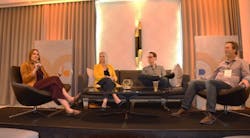Technology Reshapes the Future, But Human Element Remains Front and Center
Day two of Design Connections in Palm Springs, CA, kicked off with a lively panel discussion exploring the intersections between people and technology, and what the future of the built environment might look like.
Moderator Jacquelyn Hunter, associate interior designer at Corgan, led the discussion with panelists Jackie Dettmar, vice president of design at Mohawk Group; Joel Yow, co-founder of linear A; and John Higgs, president of Corgan MediaLab.
They discussed a series of thought-provoking questions about the relationship between new tools such as artificial intelligence (AI), augmented reality (AR) and virtual reality (VR), big data and people, and what implications they may have for design.
Technology Use
How designers utilize post-occupancy data and how they leverage the information was the first topic of discussion. As data collection becomes more sophisticated, it can arm designers with valuable information to better understand how end users utilize space and make adjustments to their designs as needed.
However, panelists noted that it also raises some interesting challenges. Because of the half-life of technology, products embedded with data-collecting sensors become obsolete much more quickly than their designed life span and will need to be updated or discarded, which is unsustainable.
Further, if products are collecting information on occupants, it raises ethical questions in terms of privacy and what is done with the data and how it’s managed.
Human Element to Data
Panelists also pondered the idea of whether collected data should be synthesized by humans or algorithms. The answer, it turns out, is both.
Yow noted that supervised machine learning will be required to ensure that humans have input in data labeling to ensure outcomes are positive. Building owners and facility managers in the future will likely need ethics committees to regulate how decisions made by AI will affect people.
For all the potential ethical and legal implications, smart environments in the future hold a great deal of promise in helping people learn or heal, for example. Sensors to track eye movement can help determine the effectiveness of signage for wayfinding in hospitals, for example.
Further, infusing scents into spaces can help trigger memories which may help dementia patients with recall. Panelists noted that branded scents are already being utilized in retail and hospitality markets to attract customers and guests.
One of the major disruptors that has impacted the industry in recent years is AR and VR. Not only does it allow clients to visualize a space and make decisions more quickly, it can allow designers to make changes early on that can save time and money.
On the product development side, Dettmar noted that AR/VR gives manufacturers the ability to test size, scale and colors, and determine how people will respond to them prior to production.
Of course, it has limitations, and the panelists agreed that product samples will never be completely eliminated because people are tactile and will always look to satisfy their innate sense of touch.
Moving the Industry Forward
Finally, Hunter asked the panelists what questions designers need to be asking to help move the industry forward. A few of the notable questions the panelists suggested are:
- Why is a particular design element or product important to a client?
- What is it solving?
- What is the client trying to achieve?
- Is it the best way to accomplish the objective or goal?
- Can we collaborate and share knowledge? If not, why?
- Can it be done another way?
In other words, the question shouldn’t just be can we do something, but why should we do it?
As the panelists noted, the industry is facing big problems, and it will require asking the right questions and bringing multidisciplinary teams to the table to help solve them.
Read next: Joyce Bromberg Talks Disruption in the A&D Industry for Design Connections 2.0 Keynote
About the Author
Robert Nieminen
Chief Content Director
Chief Content Director, Architectural Products, BUILDINGS, and interiors+sources
Robert Nieminen is the Chief Content Director of three leading B2B publications serving the commercial architecture and design industries: Architectural Products, BUILDINGS, and interiors+sources. With a career rooted in editorial excellence and a passion for storytelling, Robert oversees a diverse content portfolio that spans award-winning feature articles, strategic podcast programming, and digital media initiatives aimed at empowering design professionals, facility managers, and commercial building stakeholders.
He is the host of the I Hear Design podcast and curates the Smart Buildings Technology Report, bringing thought leadership to the forefront of innovation in built environments. Robert leads editorial and creative direction for multiple industry award programs—including the Elev8 Design Awards and Product Innovation Awards—and is a recognized voice in sustainability, smart technology integration, and forward-thinking design.
Known for his sharp editorial vision and data-informed strategies, Robert focuses on audience growth, engagement, and content monetization, leveraging AI tools and SEO-driven insights to future-proof B2B publishing.

